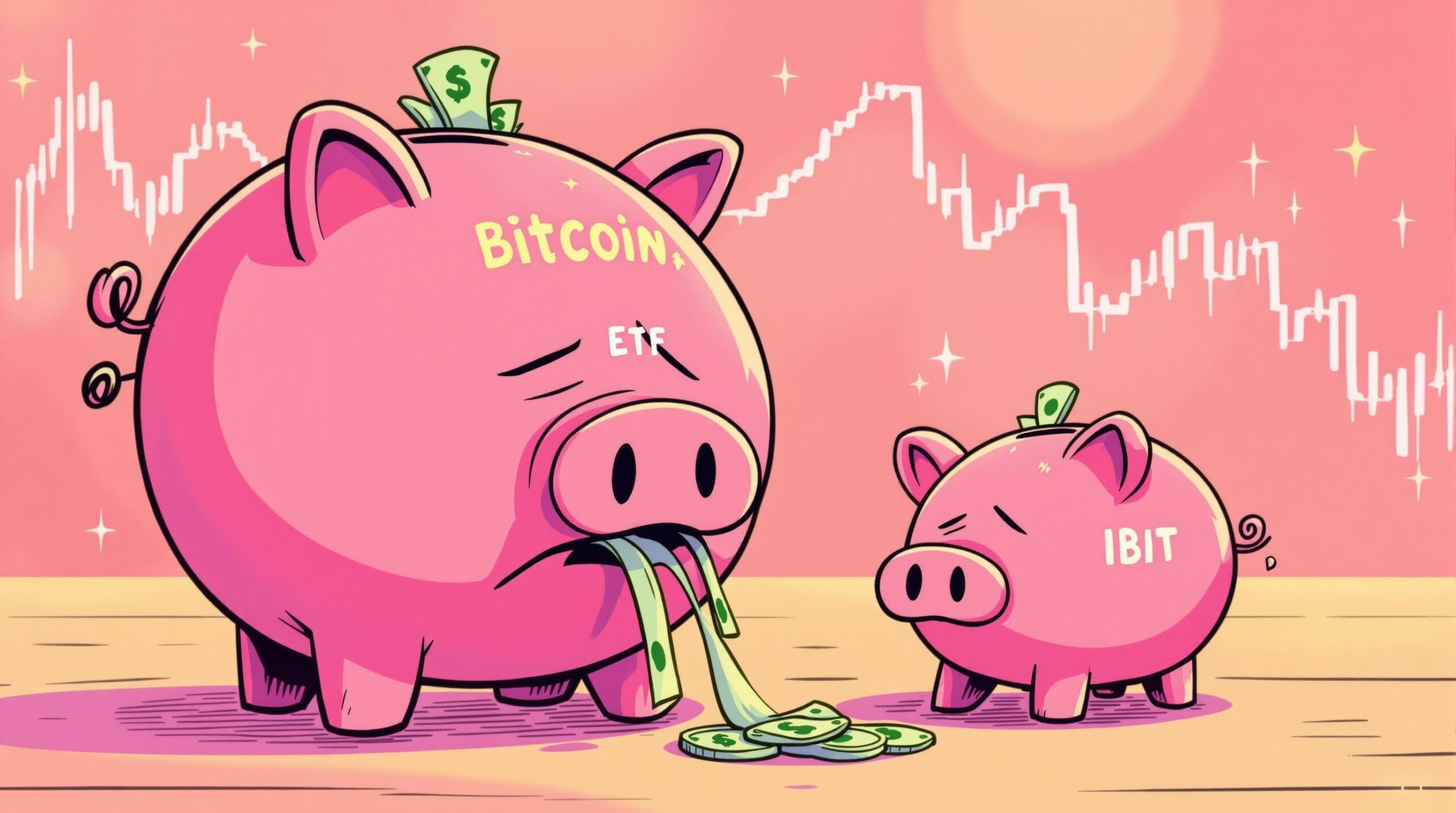BitcoinWorld

Bitcoin ETF: Crucial $86M Outflows Challenge Market Sentiment on July 23
The digital asset landscape is in constant motion, and few indicators command as much attention as the daily flows into and out of U.S. spot Bitcoin ETF products. These investment vehicles, heralded as a bridge between traditional finance and the burgeoning crypto world, offer a transparent window into institutional and retail investor sentiment. On July 23, the crypto sphere witnessed a notable shift as these highly anticipated funds recorded a collective net outflow of $86.04 million, marking the third consecutive day of negative sentiment. What does this crucial development signify for the broader market, and why are investors seemingly adjusting their positions?
This recent data, meticulously tracked and shared by prominent crypto analyst Trader T on X, has ignited discussions across trading desks and investor forums. While some funds experienced significant withdrawals, others managed to attract fresh capital, painting a complex and nuanced picture of current market dynamics. Understanding these shifts is paramount for anyone navigating the volatile yet undeniably promising realm of digital assets, particularly those looking to gauge the institutional appetite for Bitcoin ETFs.
Understanding the Recent Bitcoin ETF Outflows: A Closer Look at the Numbers
The headline figure of $86.04 million in net outflows on July 23 might appear modest when juxtaposed against the multi-trillion-dollar crypto market. However, its true significance lies in the trend it represents: this marked the third consecutive day of net withdrawals from U.S. spot Bitcoin ETFs. This sustained pattern suggests a potential recalibration of investor strategies or a reaction to broader market cues, moving beyond mere daily fluctuations.
A deeper dive into the individual fund performances reveals a nuanced story, highlighting varying degrees of investor conviction across different providers:
- Fidelity’s FBTC: Fidelity’s Wise Origin Bitcoin Fund bore the brunt of the outflows, shedding a substantial $227.24 million. This particular fund has been a strong performer and a significant recipient of inflows since its inception, making this large withdrawal particularly noteworthy and prompting questions about its underlying cause, whether it be a large institutional redemption or a broader shift in sentiment among its holders.
- ARK Invest’s ARKB: Following Fidelity, the ARK 21Shares Bitcoin ETF also contributed to the overall negative tally, recording an outflow of $9.84 million.
- Bitwise’s BITB: The Bitwise Bitcoin ETF, another popular choice among investors, also registered a modest outflow of $1.93 million for the day.
However, the picture wasn’t entirely grim. Two major players managed to buck the prevailing trend, showcasing continued investor confidence in their offerings:
- BlackRock’s IBIT: The iShares Bitcoin Trust, from the world’s largest asset manager, continued its impressive run, posting a net inflow of $142.48 million. BlackRock’s consistent ability to attract substantial capital underscores its strong market presence, the trust investors place in its brand, and potentially its broader distribution network reaching a diverse pool of investors.
- Grayscale’s mini BTC: The newly launched Grayscale Bitcoin Mini Trust (BTC), designed as a lower-fee alternative to the original Grayscale Bitcoin Trust (GBTC), saw a net inflow of $10.49 million. This suggests that while the legacy GBTC has historically seen significant outflows due to its higher fees, the new, more competitive mini version is beginning to find its footing and attract fresh capital.
The remaining U.S. spot Bitcoin ETFs reported no change in their holdings for the day, indicating a relatively stable position for those particular funds amidst the broader movements. The aggregate outflows, especially after a period of consistent inflows that followed the initial launch, signal a potential recalibration of portfolios or a reaction to broader market cues. This daily data, sourced from Trader T, provides timely and critical insights into institutional and retail investor behavior concerning these regulated investment products.
Why Are Investors Pulling Back? Unpacking the Drivers Behind Bitcoin ETF Shifts
Understanding the underlying reasons behind these significant Bitcoin ETF outflows is crucial for any market participant aiming to grasp the current sentiment. Several complex factors could be at play, influencing investor decisions to reduce their exposure to these funds:
1. Profit-Taking After Recent Rallies and ‘Sell the News’ Events
Bitcoin and the broader cryptocurrency market experienced a robust rally in the preceding months, largely fueled by the excitement and anticipation surrounding the approval of spot ETFs. For many investors who entered positions earlier in the year or during previous dips, the recent price appreciation presented an opportune moment to realize profits. This behavior is a natural part of market cycles, often observed after significant asset appreciation, particularly following a highly anticipated event like the ETF launch itself. The ‘sell the news’ phenomenon, where assets are sold off after a major positive catalyst has materialized, could also be contributing, as some investors may have bought in anticipation of the ETF approval and are now cashing out.
2. Macroeconomic Headwinds and Risk Aversion
The global economic landscape remains fraught with uncertainty. Persistent inflation, the potential for continued interest rate hikes by central banks (particularly the U.S. Federal Reserve), and ongoing geopolitical tensions can collectively lead investors to de-risk their portfolios. In such an environment, even promising, growth-oriented assets like Bitcoin might see capital diverted to more traditional, perceived-as-safer havens such as government bonds or even cash. Institutional investors, especially, tend to be highly sensitive to macroeconomic indicators and may adjust their crypto allocations based on broader economic forecasts and monetary policy signals.
3. Regulatory Scrutiny and Lingering Uncertainty
While the approval of spot Bitcoin ETFs was a landmark achievement, the broader regulatory environment for cryptocurrencies in the U.S. remains a work in progress. Delays in approvals for other crypto ETFs (such as spot Ethereum ETFs), ongoing debates about stablecoin regulation, and various enforcement actions by regulatory bodies like the SEC can contribute to a climate of caution. This regulatory ambiguity can deter new institutional money from entering the space or prompt existing investors to scale back their exposure until there is clearer guidance, impacting overall Bitcoin ETF demand.
4. Portfolio Rebalancing and Rotation into Other Assets
Investors continuously rebalance their portfolios to optimize risk and return. This could involve shifting capital from Bitcoin into other digital assets that they believe offer better short-term growth prospects, or even back into traditional equities and bonds if their outlook on those markets has improved. For instance, if the stock market shows strong performance in specific sectors, some capital might flow out of crypto to capitalize on those opportunities. Additionally, some institutional investors might be reallocating within their crypto portfolios, perhaps moving from Bitcoin into specific altcoins or DeFi protocols.
5. Specific Fund Dynamics and Institutional Redemptions
In the case of Fidelity’s FBTC experiencing a large single outflow, it could be attributed to a major institutional client rebalancing their portfolio, fulfilling redemption requests from their own clients, or even a strategic shift unique to that specific fund’s mandate. Unlike retail investors, large institutional players can move significant sums, leading to lumpier inflows and outflows that might not reflect a widespread retail exodus but rather a concentrated decision by a few large entities.
These factors often intertwine, making it challenging to pinpoint a single dominant cause. However, their cumulative effect is evident in the net outflow figures, highlighting the dynamic interplay between market fundamentals, investor psychology, and external economic forces impacting Bitcoin ETF performance.
The Ripple Effect: How Do Bitcoin ETF Flows Impact the Wider Crypto Market?
The approval and subsequent performance of U.S. spot Bitcoin ETFs were widely hailed as a watershed moment for the crypto industry. These products provide traditional investors with a regulated, accessible, and familiar way to gain exposure to Bitcoin without the complexities of directly holding the digital asset. Consequently, their inflows and outflows serve as significant, real-time indicators of institutional and broader investor appetite for digital assets.
When these ETFs experience net outflows, the ripple effect can be felt across the entire cryptocurrency ecosystem, influencing various aspects:
- Impact on Bitcoin Price: While a single day’s outflow of $86.04 million might be relatively small compared to Bitcoin’s vast daily trading volume, a sustained trend of outflows can exert consistent downward pressure on Bitcoin’s spot price. This is because ETF providers must sell underlying Bitcoin to meet redemption requests, adding to the sell-side liquidity in the open market. Conversely, strong inflows necessitate buying Bitcoin, providing upward price support.
- Shifting Market Sentiment: News of consistent outflows can erode investor confidence, both institutional and retail. It might be interpreted as a sign that institutional interest is waning, or that ‘smart money’ is taking profits, leading to a more cautious or bearish sentiment among other market participants. This psychological impact can sometimes be more potent and widespread than the direct price impact of the flows themselves, influencing trading decisions across the board.
- Liquidity Considerations: Large, concentrated outflows, particularly from major funds, can temporarily affect market liquidity. While Bitcoin is known for its high liquidity, significant selling pressure from institutional players can create temporary imbalances between buy and sell orders, potentially leading to increased price volatility.
- Validation and Legitimacy: The initial excitement around Bitcoin ETFs stemmed from their role in legitimizing crypto as a recognized asset class within traditional finance. Sustained outflows, if they become a prolonged trend, could challenge this narrative, potentially making it harder for other crypto-related products or initiatives to gain mainstream acceptance and further institutional adoption.
- Influence on Other Digital Assets: Bitcoin often acts as a bellwether for the broader crypto market. If Bitcoin’s price and sentiment are negatively impacted by ETF outflows, it can lead to a ‘risk-off’ cascade, pulling down the prices of altcoins as well, as investors become risk-averse across the entire digital asset spectrum. This interconnectedness means that Bitcoin ETF flows have implications far beyond just Bitcoin itself.
Therefore, tracking Bitcoin ETF flows isn’t merely about understanding the performance of specific funds; it’s about gauging the pulse of institutional adoption and its profound implications for the future trajectory and market perception of the entire digital asset space.
Navigating Volatility: Strategies for Investors Amidst Bitcoin ETF Dynamics
The recent Bitcoin ETF outflows serve as a potent reminder of the inherent volatility and dynamic nature of the cryptocurrency market. For both seasoned and new investors, navigating these shifts successfully requires a thoughtful, disciplined, and informed approach. Here are some actionable insights and strategies to consider amidst these evolving dynamics:
1. Maintain a Long-Term Perspective: Are You a Trader or an Investor?
Bitcoin’s history is replete with periods of significant price corrections and market FUD (Fear, Uncertainty, Doubt), often followed by new all-time highs. For many, Bitcoin represents a long-term conviction asset, a form of digital gold or a hedge against traditional financial systems. Short-term ETF flow fluctuations, while important to monitor for market sentiment, may not alter the fundamental long-term investment thesis for those who believe in Bitcoin’s foundational value proposition. Distinguish between short-term trading opportunities and long-term investment goals.
2. Diversification is Key: Don’t Put All Your Eggs in One Basket
While Bitcoin is the dominant cryptocurrency, diversifying your portfolio across different digital assets (e.g., Ethereum, stablecoins, other altcoins with strong fundamentals and distinct use cases) and traditional asset classes (equities, bonds, real estate) can help mitigate risk during periods of concentrated outflows from a single asset class. A well-diversified portfolio can cushion the impact of downturns in any one segment.
3. Implement Dollar-Cost Averaging (DCA): A Strategy for All Seasons
Instead of attempting to time the market, which is notoriously difficult even for seasoned professionals, consider implementing a dollar-cost averaging strategy. This involves investing a fixed amount of money at regular intervals (e.g., weekly or monthly), regardless of the asset’s price. DCA helps smooth out the impact of volatility by ensuring you buy more when prices are low and less when prices are high. It can be particularly effective during periods of price dips or sideways movement, allowing you to accumulate assets over time without emotional decision-making.
4. Stay Informed, But Avoid Overreaction: Differentiating Noise from Signal
Access to real-time data from reputable sources like Trader T is invaluable. However, it’s crucial to analyze these data points within a broader context. Avoid making impulsive decisions based on single-day or short-term flow data. Understand the potential underlying reasons for outflows (e.g., profit-taking vs. fundamental shifts in market structure) before reacting. Filter out sensationalist headlines and focus on fundamental analysis and long-term trends.
5. Practice Robust Risk Management and Position Sizing
Always adhere to the golden rule of investing: invest only what you can afford to lose. Given the inherent volatility of crypto, proper position sizing is critical. Ensure your allocation to Bitcoin or Bitcoin ETFs aligns with your overall risk tolerance, financial goals, and broader investment strategy. Set clear stop-loss orders if you are trading, and define your entry and exit strategies beforehand.
6. Conduct Thorough Due Diligence and Seek Professional Advice
For those investing directly in Bitcoin ETFs, familiarize yourself with the specific fund’s structure, expense ratios, underlying assets, and redemption mechanisms. While all spot Bitcoin ETFs aim to track Bitcoin’s price, their operational nuances can differ. If you are uncertain about how to incorporate Bitcoin or crypto ETFs into your financial plan, consider consulting a qualified financial advisor who specializes in digital assets. They can help you assess your risk profile and tailor a strategy that aligns with your individual circumstances.
The market’s reaction to Bitcoin ETF flows underscores the growing interconnectedness between traditional finance and the crypto world. By adopting a disciplined, informed, and strategic approach, investors can better position themselves to navigate the ebb and flow of this evolving landscape and potentially capitalize on future opportunities.
What Does the Future Hold for U.S. Spot Bitcoin ETFs?
Despite the recent period of outflows, the long-term outlook for U.S. spot Bitcoin ETFs remains largely positive for many analysts and market participants. These products represent a significant and accessible gateway for institutional capital that was previously hesitant to enter the crypto space due to regulatory, operational, or custodial complexities. As the digital asset market matures and regulatory clarity continues to improve globally, the potential for sustained and substantial inflows could very well return and even accelerate.
The ability of BlackRock’s IBIT to consistently attract significant capital, even amidst broader market outflows, suggests that demand from certain segments of the market remains robust and resilient. Furthermore, the introduction of products like Grayscale’s mini BTC indicates a dynamic and competitive landscape, with providers evolving to meet investor demands for lower fees, greater transparency, and diverse offerings.
Future flows into these ETFs will undoubtedly be influenced by a complex interplay of factors, including Bitcoin’s price performance, the broader macroeconomic environment (e.g., inflation rates, interest rate trajectories), and any further regulatory developments in the U.S. and globally. As the digital asset ecosystem continues its inevitable integration with traditional financial systems, these Bitcoin ETFs will undoubtedly play a pivotal and enduring role in shaping the trajectory of Bitcoin’s adoption, institutional integration, and overall market valuation for years to come.
Conclusion: The $86.04 million in net outflows from U.S. spot Bitcoin ETFs on July 23, marking a third consecutive day of withdrawals, serves as a significant marker in the ongoing narrative of institutional crypto adoption. While headline figures like Fidelity’s substantial outflows capture immediate attention, the continued and robust inflows into BlackRock’s IBIT and Grayscale’s mini BTC highlight a nuanced and complex market where investor sentiment is far from monolithic. These shifts underscore the dynamic nature of the digital asset market, influenced by a confluence of factors including profit-taking after rallies, prevailing macroeconomic conditions, and evolving investor strategies. Monitoring these Bitcoin ETF flows provides invaluable, real-time insights into the health and direction of institutional engagement with Bitcoin, reinforcing the critical need for investors to remain informed, adaptable, and strategically positioned in their approach to this rapidly evolving and transformative asset class.
Frequently Asked Questions (FAQs) About Bitcoin ETF Outflows
Q1: What is a U.S. spot Bitcoin ETF?
A U.S. spot Bitcoin ETF (Exchange-Traded Fund) is an investment vehicle that holds actual Bitcoin and allows investors to gain exposure to Bitcoin’s price movements through traditional stock market exchanges. Unlike Bitcoin futures ETFs, spot ETFs directly own the underlying asset, making them a more direct way for traditional investors to access Bitcoin without managing private keys or dealing with crypto exchanges.
Q2: Why are Bitcoin ETF flows important to track?
Tracking Bitcoin ETF flows is crucial because they represent institutional and large-scale retail investor sentiment and capital allocation towards Bitcoin. Significant inflows indicate strong demand and can put upward pressure on Bitcoin’s price, while outflows suggest profit-taking or a decrease in institutional appetite, potentially leading to downward price pressure. They offer a transparent view into how traditional finance is engaging with crypto.
Q3: What factors contribute to Bitcoin ETF outflows?
Several factors can contribute to Bitcoin ETF outflows, including profit-taking after price rallies, broader macroeconomic concerns (like inflation or interest rate hikes), regulatory uncertainty in the crypto space, portfolio rebalancing by large institutions, and shifts in market sentiment or risk appetite. Sometimes, a large single redemption from an institutional client can also significantly impact daily figures.
Q4: How do these outflows impact Bitcoin’s price?
When a Bitcoin ETF experiences outflows, the fund manager typically has to sell a corresponding amount of Bitcoin to meet redemption requests. This selling pressure adds to the supply in the spot market, which can contribute to downward pressure on Bitcoin’s price. While daily flows might be small compared to Bitcoin’s total trading volume, sustained outflows can have a more noticeable impact on market sentiment and price trajectory.
Q5: Is it normal for ETFs to experience outflows?
Yes, it is entirely normal for any ETF, including Bitcoin ETFs, to experience periods of net outflows. ETFs are designed to be liquid and allow investors to buy and sell shares freely throughout the trading day. Outflows are a natural part of the investment cycle, reflecting investors’ decisions to rebalance portfolios, take profits, or respond to changing market conditions or personal financial goals.
Q6: What is the difference between BlackRock’s IBIT inflows and Fidelity’s FBTC outflows on July 23?
On July 23, BlackRock’s IBIT saw net inflows, meaning more money flowed into the fund than out, indicating continued demand for their specific Bitcoin ETF product. Conversely, Fidelity’s FBTC experienced net outflows, meaning more money was withdrawn from the fund than invested. This highlights that while the overall market saw net outflows, investor sentiment and allocation decisions can vary significantly between different ETF providers, reflecting diverse strategies and client bases.
If you found this article insightful and believe it sheds light on crucial market dynamics, please consider sharing it with your network on social media. Your support helps us continue to provide valuable analysis and keep the crypto community informed!
To learn more about the latest crypto market trends, explore our article on key developments shaping Bitcoin institutional adoption.
This post Bitcoin ETF: Crucial $86M Outflows Challenge Market Sentiment on July 23 first appeared on BitcoinWorld and is written by Editorial Team





